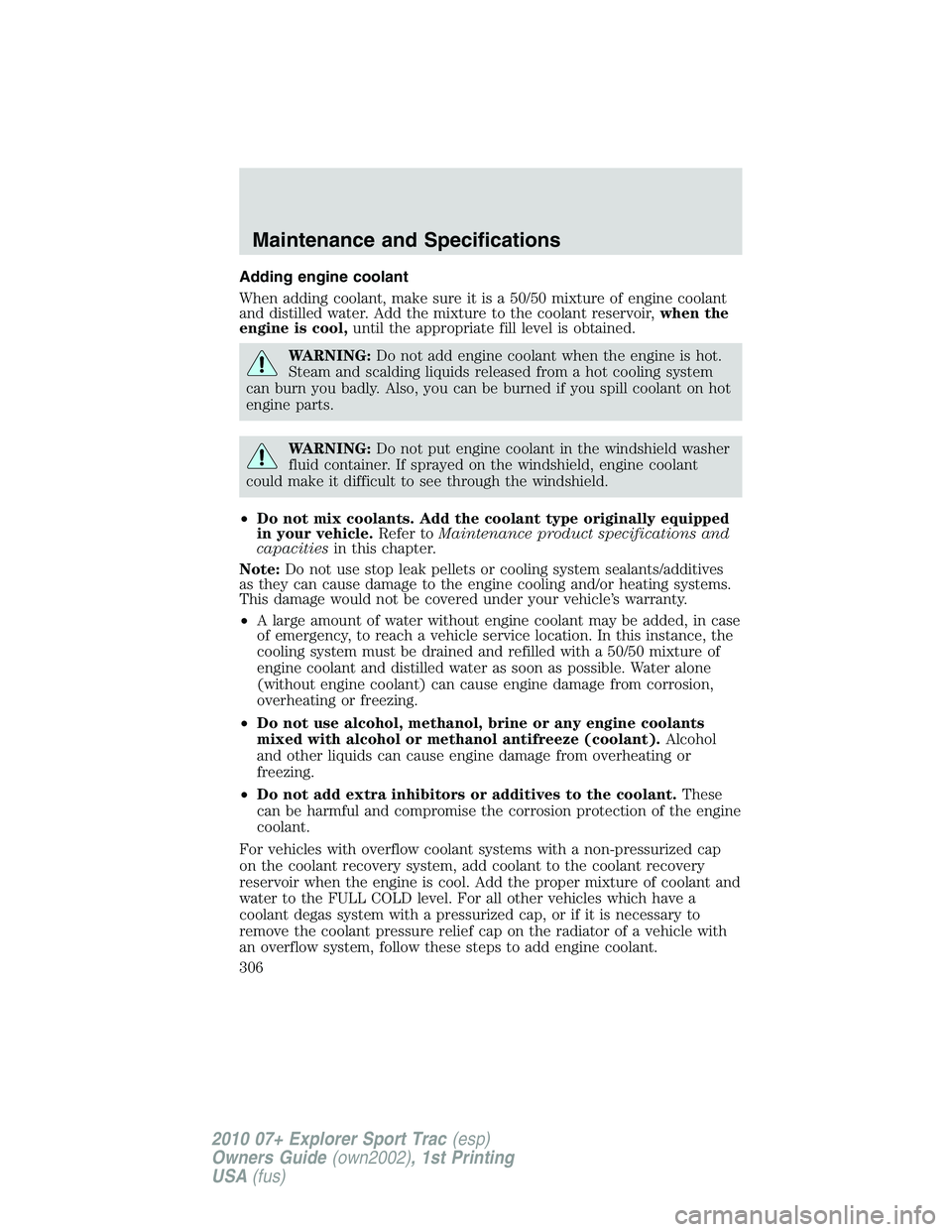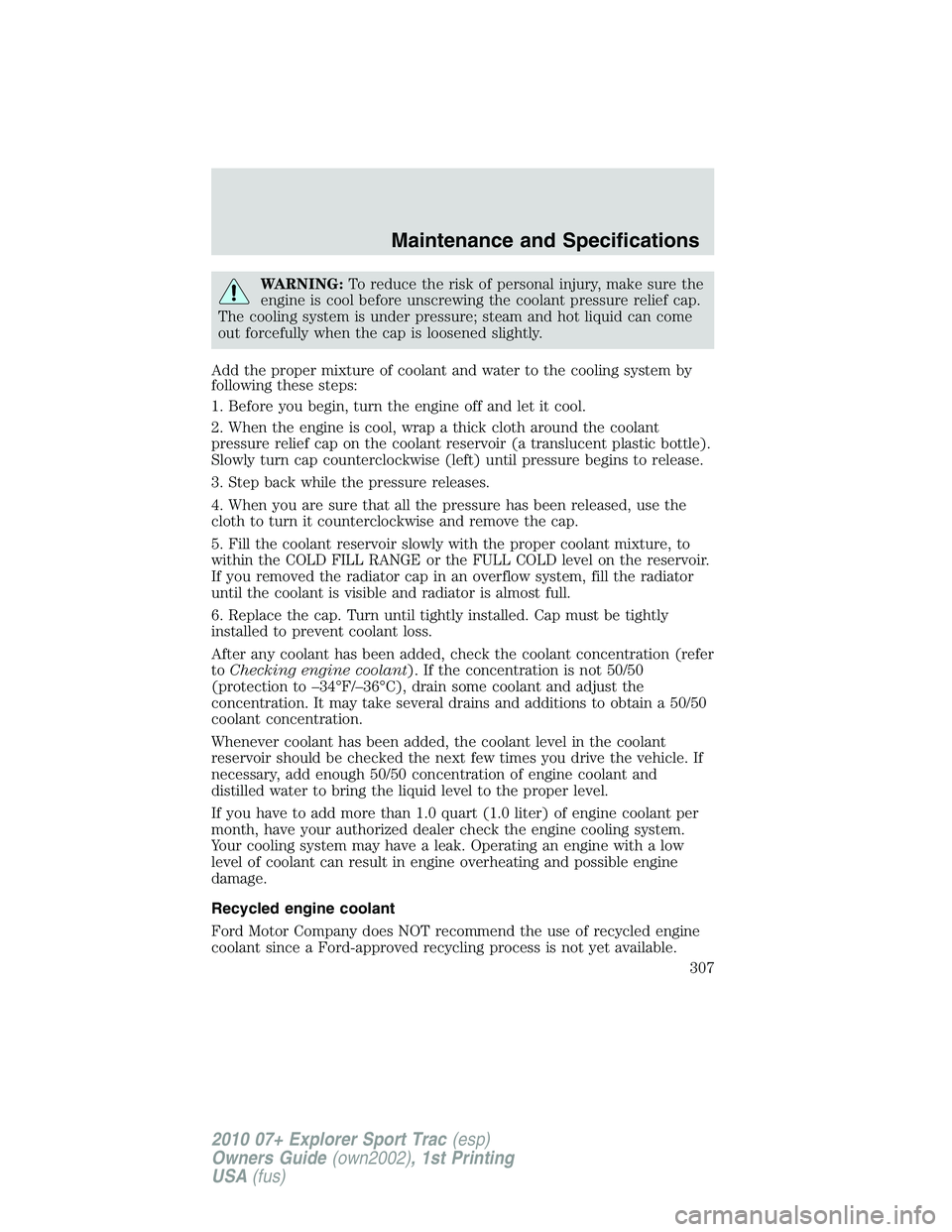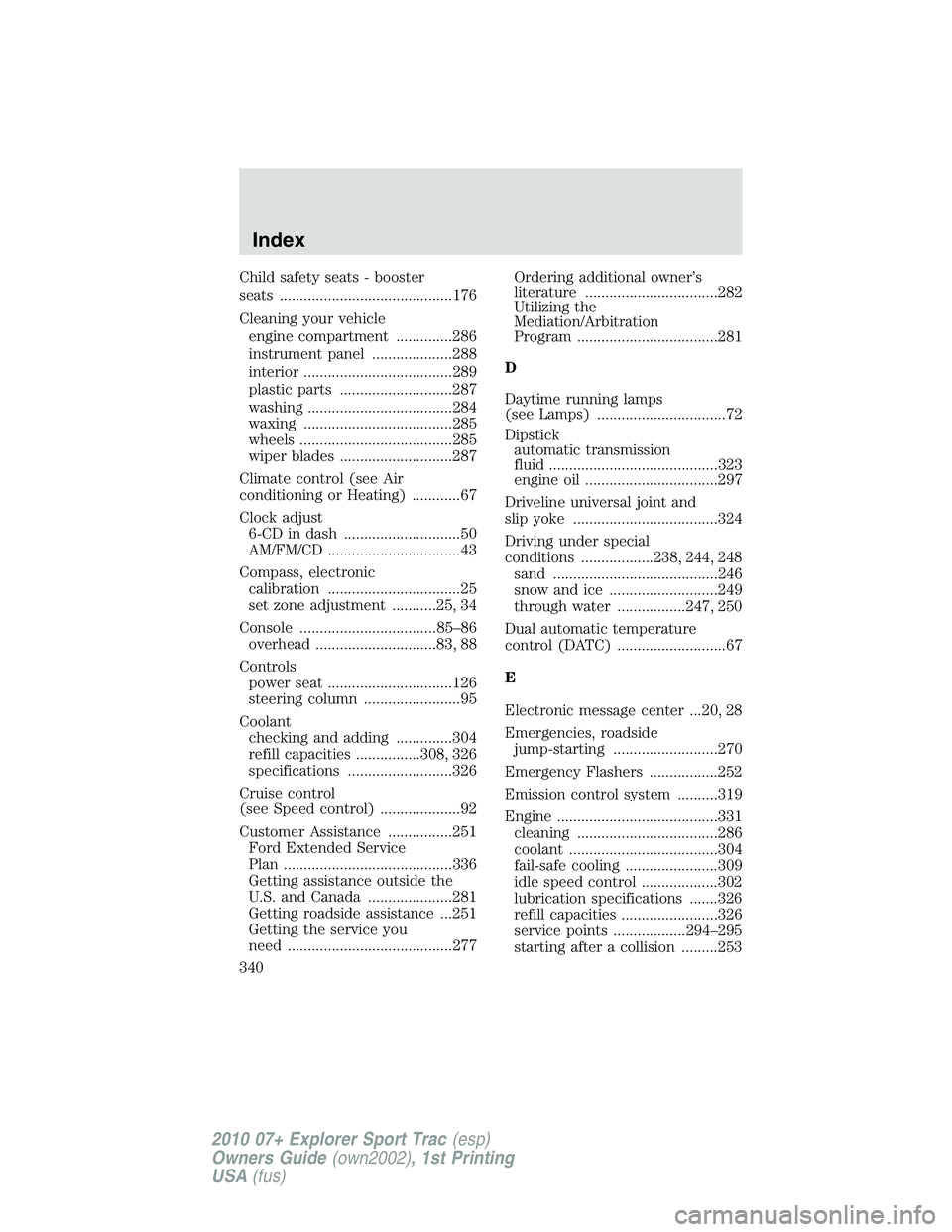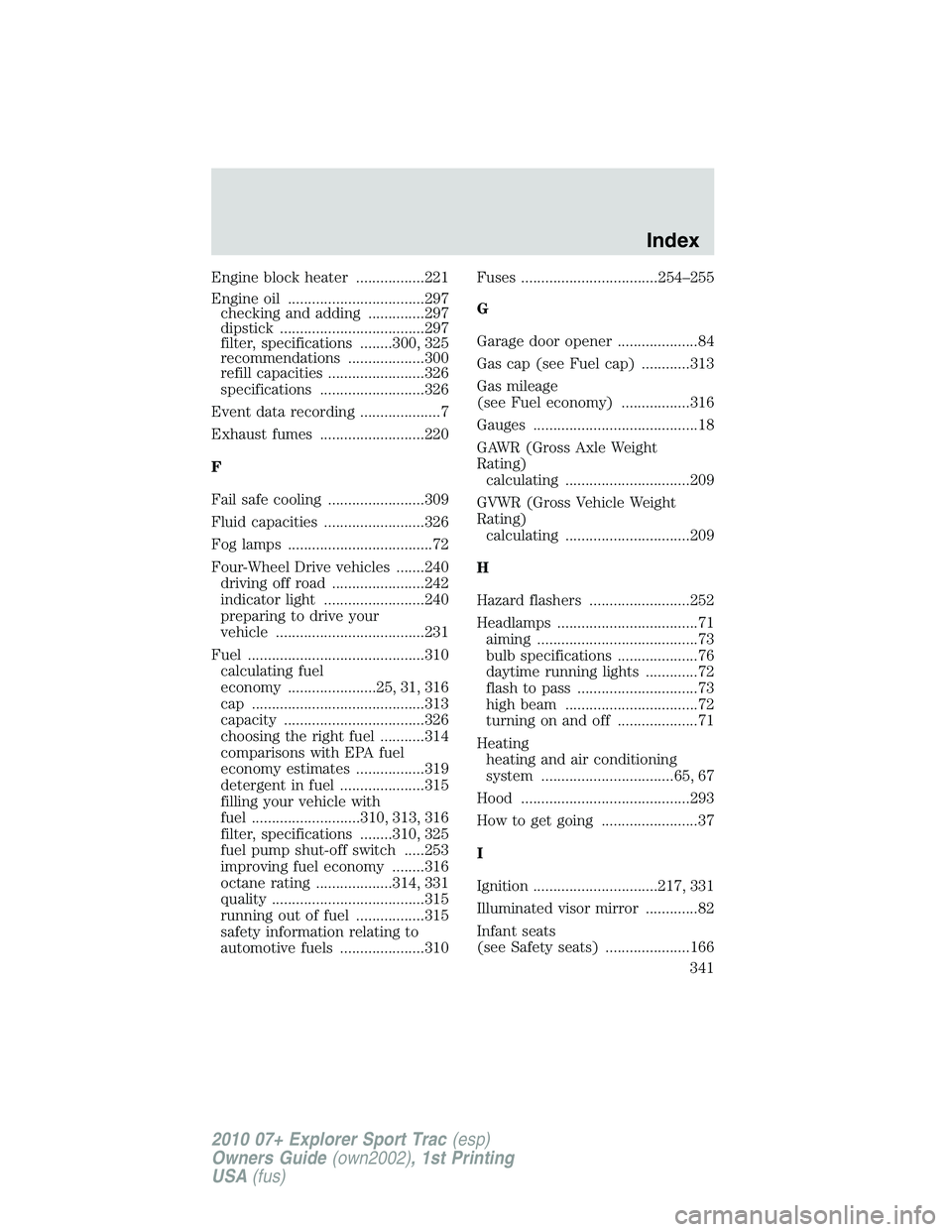2010 FORD EXPLORER SPORT TRAC heating
[x] Cancel search: heatingPage 306 of 344

Adding engine coolant
When adding coolant, make sure it is a 50/50 mixture of engine coolant
and distilled water. Add the mixture to the coolant reservoir,when the
engine is cool,until the appropriate fill level is obtained.
WARNING:Do not add engine coolant when the engine is hot.
Steam and scalding liquids released from a hot cooling system
can burn you badly. Also, you can be burned if you spill coolant on hot
engine parts.
WARNING:Do not put engine coolant in the windshield washer
fluid container. If sprayed on the windshield, engine coolant
could make it difficult to see through the windshield.
•Do not mix coolants. Add the coolant type originally equipped
in your vehicle.Refer toMaintenance product specifications and
capacitiesin this chapter.
Note:Do not use stop leak pellets or cooling system sealants/additives
as they can cause damage to the engine cooling and/or heating systems.
This damage would not be covered under your vehicle’s warranty.
•A large amount of water without engine coolant may be added, in case
of emergency, to reach a vehicle service location. In this instance, the
cooling system must be drained and refilled with a 50/50 mixture of
engine coolant and distilled water as soon as possible. Water alone
(without engine coolant) can cause engine damage from corrosion,
overheating or freezing.
•Do not use alcohol, methanol, brine or any engine coolants
mixed with alcohol or methanol antifreeze (coolant).Alcohol
and other liquids can cause engine damage from overheating or
freezing.
•Do not add extra inhibitors or additives to the coolant.These
can be harmful and compromise the corrosion protection of the engine
coolant.
For vehicles with overflow coolant systems with a non-pressurized cap
on the coolant recovery system, add coolant to the coolant recovery
reservoir when the engine is cool. Add the proper mixture of coolant and
water to the FULL COLD level. For all other vehicles which have a
coolant degas system with a pressurized cap, or if it is necessary to
remove the coolant pressure relief cap on the radiator of a vehicle with
an overflow system, follow these steps to add engine coolant.
Maintenance and Specifications
306
2010 07+ Explorer Sport Trac(esp)
Owners Guide(own2002), 1st Printing
USA(fus)
Page 307 of 344

WARNING:To reduce the risk of personal injury, make sure the
engine is cool before unscrewing the coolant pressure relief cap.
The cooling system is under pressure; steam and hot liquid can come
out forcefully when the cap is loosened slightly.
Add the proper mixture of coolant and water to the cooling system by
following these steps:
1. Before you begin, turn the engine off and let it cool.
2. When the engine is cool, wrap a thick cloth around the coolant
pressure relief cap on the coolant reservoir (a translucent plastic bottle).
Slowly turn cap counterclockwise (left) until pressure begins to release.
3. Step back while the pressure releases.
4. When you are sure that all the pressure has been released, use the
cloth to turn it counterclockwise and remove the cap.
5. Fill the coolant reservoir slowly with the proper coolant mixture, to
within the COLD FILL RANGE or the FULL COLD level on the reservoir.
If you removed the radiator cap in an overflow system, fill the radiator
until the coolant is visible and radiator is almost full.
6. Replace the cap. Turn until tightly installed. Cap must be tightly
installed to prevent coolant loss.
After any coolant has been added, check the coolant concentration (refer
toChecking engine coolant). If the concentration is not 50/50
(protection to –34°F/–36°C), drain some coolant and adjust the
concentration. It may take several drains and additions to obtain a 50/50
coolant concentration.
Whenever coolant has been added, the coolant level in the coolant
reservoir should be checked the next few times you drive the vehicle. If
necessary, add enough 50/50 concentration of engine coolant and
distilled water to bring the liquid level to the proper level.
If you have to add more than 1.0 quart (1.0 liter) of engine coolant per
month, have your authorized dealer check the engine cooling system.
Your cooling system may have a leak. Operating an engine with a low
level of coolant can result in engine overheating and possible engine
damage.
Recycled engine coolant
Ford Motor Company does NOT recommend the use of recycled engine
coolant since a Ford-approved recycling process is not yet available.
Maintenance and Specifications
307
2010 07+ Explorer Sport Trac(esp)
Owners Guide(own2002), 1st Printing
USA(fus)
Page 340 of 344

Child safety seats - booster
seats ...........................................176
Cleaning your vehicle
engine compartment ..............286
instrument panel ....................288
interior .....................................289
plastic parts ............................287
washing ....................................284
waxing .....................................285
wheels ......................................285
wiper blades ............................287
Climate control (see Air
conditioning or Heating) ............67
Clock adjust
6-CD in dash .............................50
AM/FM/CD .................................43
Compass, electronic
calibration .................................25
set zone adjustment ...........25, 34
Console ..................................85–86
overhead ..............................83, 88
Controls
power seat ...............................126
steering column ........................95
Coolant
checking and adding ..............304
refill capacities ................308, 326
specifications ..........................326
Cruise control
(see Speed control) ....................92
Customer Assistance ................251
Ford Extended Service
Plan ..........................................336
Getting assistance outside the
U.S. and Canada .....................281
Getting roadside assistance ...251
Getting the service you
need .........................................277Ordering additional owner’s
literature .................................282
Utilizing the
Mediation/Arbitration
Program ...................................281
D
Daytime running lamps
(see Lamps) ................................72
Dipstick
automatic transmission
fluid ..........................................323
engine oil .................................297
Driveline universal joint and
slip yoke ....................................324
Driving under special
conditions ..................238, 244, 248
sand .........................................246
snow and ice ...........................249
through water .................247, 250
Dual automatic temperature
control (DATC) ...........................67
E
Electronic message center ...20, 28
Emergencies, roadside
jump-starting ..........................270
Emergency Flashers .................252
Emission control system ..........319
Engine ........................................331
cleaning ...................................286
coolant .....................................304
fail-safe cooling .......................309
idle speed control ...................302
lubrication specifications .......326
refill capacities ........................326
service points ..................294–295
starting after a collision .........253
Index
340
2010 07+ Explorer Sport Trac(esp)
Owners Guide(own2002), 1st Printing
USA(fus)
Page 341 of 344

Engine block heater .................221
Engine oil ..................................297
checking and adding ..............297
dipstick ....................................297
filter, specifications ........300, 325
recommendations ...................300
refill capacities ........................326
specifications ..........................326
Event data recording ....................7
Exhaust fumes ..........................220
F
Fail safe cooling ........................309
Fluid capacities .........................326
Fog lamps ....................................72
Four-Wheel Drive vehicles .......240
driving off road .......................242
indicator light .........................240
preparing to drive your
vehicle .....................................231
Fuel ............................................310
calculating fuel
economy ......................25, 31, 316
cap ...........................................313
capacity ...................................326
choosing the right fuel ...........314
comparisons with EPA fuel
economy estimates .................319
detergent in fuel .....................315
filling your vehicle with
fuel ...........................310, 313, 316
filter, specifications ........310, 325
fuel pump shut-off switch .....253
improving fuel economy ........316
octane rating ...................314, 331
quality ......................................315
running out of fuel .................315
safety information relating to
automotive fuels .....................310Fuses ..................................254–255
G
Garage door opener ....................84
Gas cap (see Fuel cap) ............313
Gas mileage
(see Fuel economy) .................316
Gauges .........................................18
GAWR (Gross Axle Weight
Rating)
calculating ...............................209
GVWR (Gross Vehicle Weight
Rating)
calculating ...............................209
H
Hazard flashers .........................252
Headlamps ...................................71
aiming ........................................73
bulb specifications ....................76
daytime running lights .............72
flash to pass ..............................73
high beam .................................72
turning on and off ....................71
Heating
heating and air conditioning
system .................................65, 67
Hood ..........................................293
How to get going ........................37
I
Ignition ...............................217, 331
Illuminated visor mirror .............82
Infant seats
(see Safety seats) .....................166
Index
341
2010 07+ Explorer Sport Trac(esp)
Owners Guide(own2002), 1st Printing
USA(fus)